Assessing the Rural–Urban Transition of China during 1980–2020 from a Coordination Perspective
Abstract
1. Introduction
2. Methodology
2.1. Conceptual Framework
2.2. Index System Construction
2.2.1. Weight Measurement
2.2.2. Index Calculation
2.2.3. Measurement of ΔURDI and ΔURII
2.2.4. Measurement of Rural–Urban Transition Coordination Degree
2.2.5. Data Sources
3. Results and Analysis
3.1. Characteristics of the URDI and the URII
3.2. Spatial Pattern of the URDI and the URII
3.3. Coupling Relationships between the URDI and the URII
3.4. Spatial Pattern of Rural–Urban Transition
3.5. Coordination Degree Analysis of Rural–Urban Transition
4. Discussion
4.1. The Optimal Path of Rural–Urban Transition
4.2. Policy Implications
4.3. Limitations and Future Research
5. Conclusions
- (1)
- In general, China’s URDI has increased rapidly since the 1980s, with regional disparity expanding substantially. The URII has experienced a trend of first decreasing and then increasing, and the difference between regions is gradually decreasing. The positive correlation between URDI and URII has gradually decoupled from 1980 to 2020.
- (2)
- From 1980–2000, the intensity of the rural–urban transition in China has tremendous regional and temporal differences. The ΔURDI has shown the spatial characteristics of the “south high–north low”, while the ΔURII is relatively evenly distributed. The high-value areas of coordination degree show the spatial pattern of coastal and riverine “T-shape”.
- (3)
- Ten types of regions are identified based on rural–urban state and transition. The decline of coordination is obvious in high-quality regions. In lagging integration regions, the higher the URDI, the transition is more uncoordinated; in double-lagging regions, high URDI means more coordination in the rural–urban transition.
Author Contributions
Funding
Institutional Review Board Statement
Informed Consent Statement
Data Availability Statement
Conflicts of Interest
References
- Kay, C. Development Strategies and Rural Development: Exploring Synergies, Eradicating Poverty. J. Peasant Stud. 2009, 36, 103–137. [Google Scholar] [CrossRef]
- De Haan, L.J. The Question of Development and Environment in Geography in the Era of Globalisation. GeoJournal 2000, 50, 359–367. [Google Scholar] [CrossRef]
- Montgomery, M.R. The Urban Transformation of the Developing World. Science 2008, 319, 761–764. [Google Scholar] [CrossRef]
- Sahn, D.E.; Stifel, D.C. Urban-Rural Inequality in Living Standards in Africa. J. Afr. Econ. 2004, 13, 564–597. [Google Scholar] [CrossRef]
- Sehrawat, M.; Giri, A.K. Panel Data Analysis of Financial Development, Economic Growth and Rural-Urban Income Inequality Evidence from SAARC Countries. Int. J. Soc. Econ. 2016, 43, 998–1015. [Google Scholar] [CrossRef]
- Scott, M. Resilience: A Conceptual Lens for Rural Studies? Geogr. Compass 2013, 7, 597–610. [Google Scholar] [CrossRef]
- Peou, C. Negotiating Rural-Urban Transformation and Life Course Fluidity: Rural Young People and Urban Sojourn in Contemporary Cambodia. J. Rural Stud. 2016, 44, 177–186. [Google Scholar] [CrossRef]
- Delgado-Viñas, C.; Gómez-Moreno, M.-L. The Interaction between Urban and Rural Areas: An Updated Paradigmatic, Methodological and Bibliographic Review. Land 2022, 11, 1298. [Google Scholar] [CrossRef]
- Spoor, M. Multidimensional Social Exclusion and the “Rural-Urban Divide” in Eastern Europe and Central Asia. Sociol. Rural. 2013, 53, 139–157. [Google Scholar] [CrossRef]
- Somanje, A.N.; Mohan, G.; Lopes, J.; Mensah, A.; Gordon, C.; Zhou, X.; Moinuddin, M.; Saito, O.; Takeuchi, K. Challenges and Potential Solutions for Sustainable Urban-Rural Linkages in a Ghanaian Context. Sustainability 2020, 12, 507. [Google Scholar] [CrossRef]
- UN. Transforming Our World: The 2030 Agenda for Sustainable Development; United Nations: New York, NY, USA, 2015; Volume 16301. [Google Scholar]
- Yu, A.T.W.; Wu, Y.; Zheng, B.; Zhang, X.; Shen, L. Identifying Risk Factors of Urban-Rural Conflict in Urbanization: A Case of China. Habitat Int. 2014, 44, 177–185. [Google Scholar] [CrossRef]
- Chen, K.; Long, H.; Liao, L.; Tu, S.; Li, T. Land Use Transitions and Urban-Rural Integrated Development: Theoretical Framework and China’s Evidence. Land Use Policy 2020, 92, 104465. [Google Scholar] [CrossRef]
- Zhu, J.; Zhu, M.; Xiao, Y. Urbanization for Rural Development: Spatial Paradigm Shifts toward Inclusive Urban-Rural Integrated Development in China. J. Rural Stud. 2019, 71, 94–103. [Google Scholar] [CrossRef]
- Zhu, H.; Gao, X.; Lin, Y.; He, Y. Land-Development-Right Pricing Based on Spatial Characteristics in Urban Local Function Regeneration. Land 2022, 11, 2113. [Google Scholar] [CrossRef]
- Khmara, Y.; Kronenberg, J. On the Road to Urban Degrowth Economics? Learning from the Experience of C40 Cities, Doughnut Cities, Transition Towns, and Shrinking Cities. Cities 2023, 136, 104259. [Google Scholar] [CrossRef]
- Lu, Q.; Yao, S. From Urban-Rural Division to Urban-Rural Integration: A Systematic Cost Explanation and Chengdu’s Experience. China World Econ. 2018, 26, 86–105. [Google Scholar] [CrossRef]
- Lewis, W.A. Economic Development with Unlimited.d Supplies of Labour. Manch. Sch. 1954, 22, 139–191. [Google Scholar] [CrossRef]
- Ranis, G.; Fei, J.C.H. A Theory of Economic Development. Am. Econ. Rev. 1961, 51, 533–565. [Google Scholar]
- Jorgenson, D.W. The Development of Dual Economic. Econ. J. 1961, 71, 309–334. [Google Scholar] [CrossRef]
- Myrdal, G.; Sitohang, P. Economic Theory and Under-Developed Regions; Duckworth: London, UK, 1957. [Google Scholar]
- Friedmann, J. The Future of Periurban Research. Cities 2016, 53, 163–165. [Google Scholar] [CrossRef]
- Mcgee, T. The Emergence of Desakota Regions in Asia: Expanding a Hypothesis; University of Hawaii Press: Honolulu, HI, USA, 1991. [Google Scholar]
- Mauro, G. Rural–Urban Transition of Hanoi (Vietnam): Using Landsat Imagery to Map Its Recent Peri-Urbanization. ISPRS Int. J. Geo-Inf. 2020, 9, 669. [Google Scholar] [CrossRef]
- Jedwab, R.; Christiaensen, L.; Gindelsky, M. Demography, Urbanization and Development: Rural Push, Urban Pull and … Urban Push? J. Urban. Econ. 2017, 98, 6–16. [Google Scholar] [CrossRef]
- Lagüera Díaz, S. Urban Rural Interaction: Processes and Changes in the Marina Oriental of Cantabria (Spain). Land 2023, 12, 166. [Google Scholar] [CrossRef]
- Lerch, M. The Role of Migration in the Urban Transition: A Demonstration From Albania. Demography 2014, 51, 1527–1550. [Google Scholar] [CrossRef]
- Zhao, P. Urban-Rural Transition in China’s Metropolises: New Trends in Peri-Urbanisation in Beijing. Int. Dev. Plan. Rev. 2012, 34, 269–294. [Google Scholar] [CrossRef]
- Li, T.; Long, H.; Liu, Y.; Tu, S. Multi-Scale Analysis of Rural Housing Land Transition under China’s Rapid Urbanization: The Case of Bohai Rim. Habitat Int. 2015, 48, 227–238. [Google Scholar] [CrossRef]
- Liu, Y.; Long, H.; Chen, Y.; Wang, J.; Li, Y.; Li, Y.; Yang, Y.; Zhou, Y. Progress of Research on Urban-Rural Transformation and Rural Development in China in the Past Decade and Future Prospects. J. Geogr. Sci. 2016, 26, 1117–1132. [Google Scholar] [CrossRef]
- Yang, Y.; Liu, Y.; Li, Y.; Li, J. Measure of Urban-Rural Transformation in Beijing-Tianjin-Hebei Region in the New Millennium: Population-Land-Industry Perspective. Land Use Policy 2018, 79, 595–608. [Google Scholar] [CrossRef]
- Handayani, W. Rural-Urban Transition in Central Java: Population and Economic Structural Changes Based on Cluster Analysis. Land 2013, 2, 419–436. [Google Scholar] [CrossRef]
- Bosworth, G.; Venhorst, V. Economic Linkages between Urban and Rural Regions–What’s in It for the Rural? Reg. Stud. 2018, 52, 1075–1085. [Google Scholar] [CrossRef]
- Douglass, M. A Regional Network Strategy for Reciprocal Rural-Urban Linkages: An Agenda for Policy Research with Reference to Indonesia. Int. Dev. Plan. Rev. 1998, 20, 1–30. [Google Scholar] [CrossRef]
- Bencardino, M.; Nesticò, A. Demographic Changes and Real Estate Values. A Quantitative Model for Analyzing the Urban-Rural Linkages. Sustainability 2017, 9, 536. [Google Scholar] [CrossRef]
- Hu, Z.; Wang, Y.; Liu, Y.; Long, H.; Peng, J. Spatio-Temporal Patterns of Urban-Rural Development and Transformation in East of the “Hu Huanyong Line”, China. ISPRS Int. J. Geo-Inf. 2016, 5, 24. [Google Scholar] [CrossRef]
- Yang, Y.; Bao, W.; Wang, Y.; Liu, Y. Measurement of Urban-Rural Integration Level and Its Spatial Differentiation in China in the New Century. Habitat Int. 2021, 117, 102420. [Google Scholar] [CrossRef]
- Niu, X.; Liao, F.; Liu, Z.; Wu, G. Spatial–Temporal Characteristics and Driving Mechanisms of Land–Use Transition from the Perspective of Urban–Rural Transformation Development: A Case Study of the Yangtze River Delta. Land 2022, 11, 631. [Google Scholar] [CrossRef]
- Wang, Z.; Xu, X.; Wang, H.; Meng, S. Does Land Reserve System Improve Quality of Urbanization? Evidence from China. Habitat Int. 2020, 106, 102291. [Google Scholar] [CrossRef]
- Chen, W.; Cheshmehzangi, A.; Mangi, E.; Heath, T. Implementations of China’s New-Type Urbanisation: A Comparative Analysis between Targets and Practices of Key Elements’ Policies. Sustainability 2022, 14, 6341. [Google Scholar] [CrossRef]
- Long, H. Land Use Transitions and Rural Restructuring in China; Springer Nature: Singapore, 2020; ISBN 978-981-15-4923-6. [Google Scholar]
- Ma, L.; Chen, M.; Fang, F.; Che, X. Research on the Spatiotemporal Variation of Rural-Urban Transformation and Its Driving Mechanisms in Underdeveloped Regions: Gansu Province in Western China as an Example. Sustain. Cities Soc. 2019, 50, 101675. [Google Scholar] [CrossRef]
- Yan, L.; Hong, K.; Chen, K.; Li, H.; Liao, L. Benefit Distribution of Collectively-Owned Operating Construction Land Entering the Market in Rural China: A Multiple Principal–Agent Theory-Based Analysis. Habitat Int. 2021, 109, 102328. [Google Scholar] [CrossRef]
- Wang, Y.; Liu, Y.; Li, Y.; Li, T. The Spatio-Temporal Patterns of Urban-Rural Development Transformation in China since 1990. Habitat Int. 2016, 53, 178–187. [Google Scholar] [CrossRef]
- Diakoulaki, D.; Mavrotas, G.; Papayannakis, L. Determining Objective Weights in Multiple Criteria Problems: The Critic Method. Comput. Oper. Res. 1995, 22, 763–770. [Google Scholar] [CrossRef]
- Zhang, Y.; Long, H.; Ma, L.; Ge, D.; Tu, S.; Qu, Y. Farmland Function Evolution in the Huang-Huai-Hai Plain: Processes, Patterns and Mechanisms. J. Geogr. Sci. 2018, 28, 759–777. [Google Scholar] [CrossRef]
- Fujita, M.; Hu, D. Regional Disparity in China 1985–1994: The Effects of Globalization and Economic Liberalization. Ann. Reg. Sci. 2001, 35, 3–37. [Google Scholar] [CrossRef]
- Choithani, C.; van Duijne, R.J.; Nijman, J. Changing Livelihoods at India’s Rural–Urban Transition. World Dev. 2021, 146, 105617. [Google Scholar] [CrossRef]
- Ma, Z.; Ran, R.; Xu, D. The Effect of Peasants Differentiation on Peasants’ Willingness and Behavior Transformation of Land Transfer: Evidence from Sichuan Province, China. Land 2023, 12, 338. [Google Scholar] [CrossRef]
- Dingde Xu Zhuolin Yong, X.D.L.Z.C.Q. Rural-Urban Migration and Its Effect on Land Transfer in Rural China. Land 2020, 9, 81. [Google Scholar] [CrossRef]
- Pugh, C. “Urban Bias”, the Political Economy of Development and Urban Policies for Developing Countries. Urban Stud. 1996, 33, 1045–1060. [Google Scholar] [CrossRef]
- Kurnia, A.A.; Rustiadi, E.; Fauzi, A.; Pravitasari, A.E.; Ženka, J. Probing Regional Disparities and Their Characteristics in a Suburb of a Global South Megacity: The Case of Bekasi Regency, Jakarta Metropolitan Region. ISPRS Int. J. Geo-Inf. 2023, 12, 32. [Google Scholar] [CrossRef]
- Liu, Z. Land-Based Finance and Property Tax in China. Area Dev. Policy 2019, 4, 368–382. [Google Scholar] [CrossRef]
- Lin, G.C.S.; Zhang, A.Y. Emerging Spaces of Neoliberal Urbanism in China: Land Commodification, Municipal Finance and Local Economic Growth in Prefecture-Level Cities. Urban. Stud. 2015, 52, 2774–2798. [Google Scholar] [CrossRef]
- Berrisford, S.; Cirolia, L.R.; Palmer, I. Land-Based Financing in Sub-Saharan African Cities. Env. Urban. 2018, 30, 35–52. [Google Scholar] [CrossRef]
- Sinha, M. Harnessing Land Value Capture: Perspectives from India’s Urban Rail Corridors. Land Use Policy 2021, 108, 105526. [Google Scholar] [CrossRef]
- He, Q.; Zhou, J.; Tan, S.; Song, Y.; Zhang, L.; Mou, Y.; Wu, J. What Is the Developmental Level of Outlying Expansion Patches? A Study of 275 Chinese Cities Using Geographical Big Data. Cities 2020, 105, 102395. [Google Scholar] [CrossRef]
- Zhang, S.; Wang, L.; Lu, F. Exploring Housing Rent by Mixed Geographically Weighted Regression: A Case Study in Nanjing. ISPRS Int. J. Geo-Inf. 2019, 8, 431. [Google Scholar] [CrossRef]
- Hawley, Z.; Miranda, J.J.; Sawyer, W.C. Land Values, Property Rights, and Home Ownership: Implications for Property Taxation in Peru. Reg. Sci. Urban. Econ. 2018, 69, 38–47. [Google Scholar] [CrossRef]
- Jiang, Y.; Long, H.; Ives, C.D.; Deng, W.; Chen, K.; Zhang, Y. Modes and Practices of Rural Vitalisation Promoted by Land Consolidation in a Rapidly Urbanising China: A Perspective of Multifunctionality. Habitat Int. 2022, 121, 102514. [Google Scholar] [CrossRef]
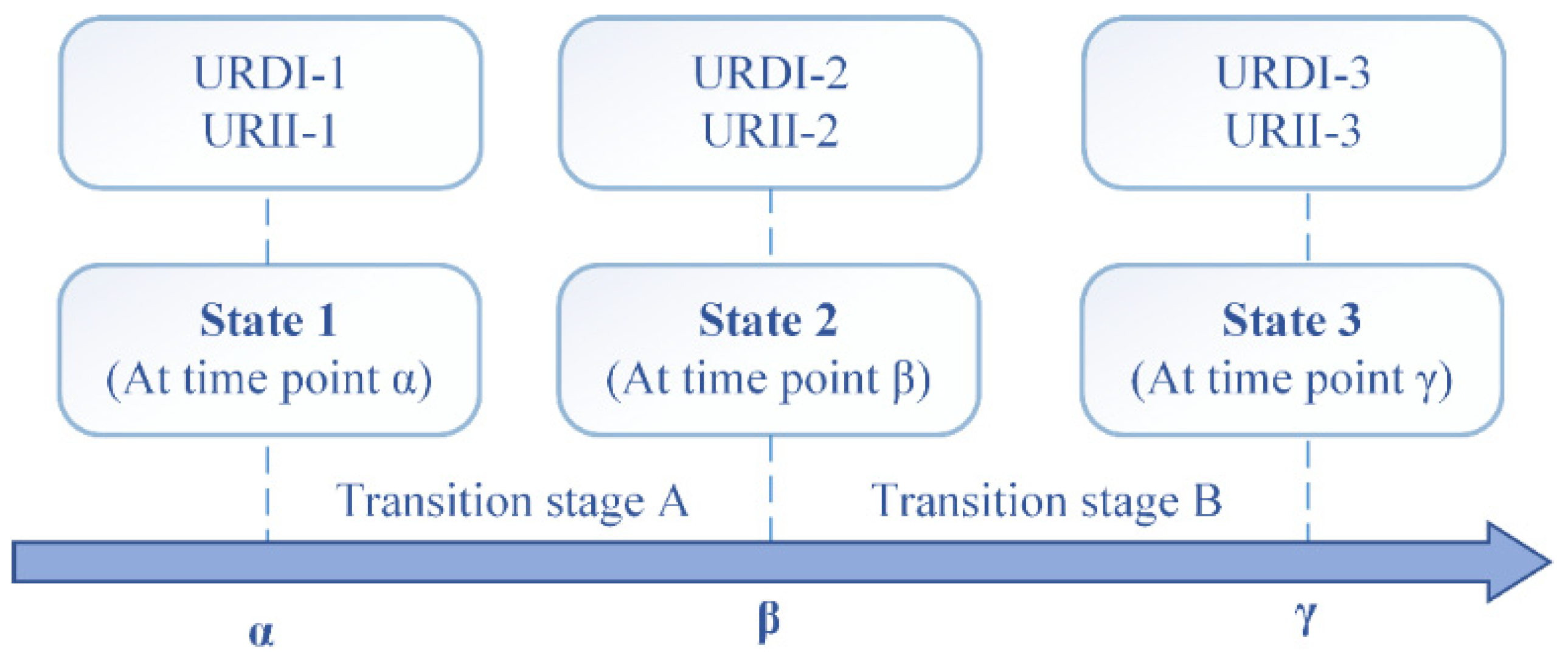
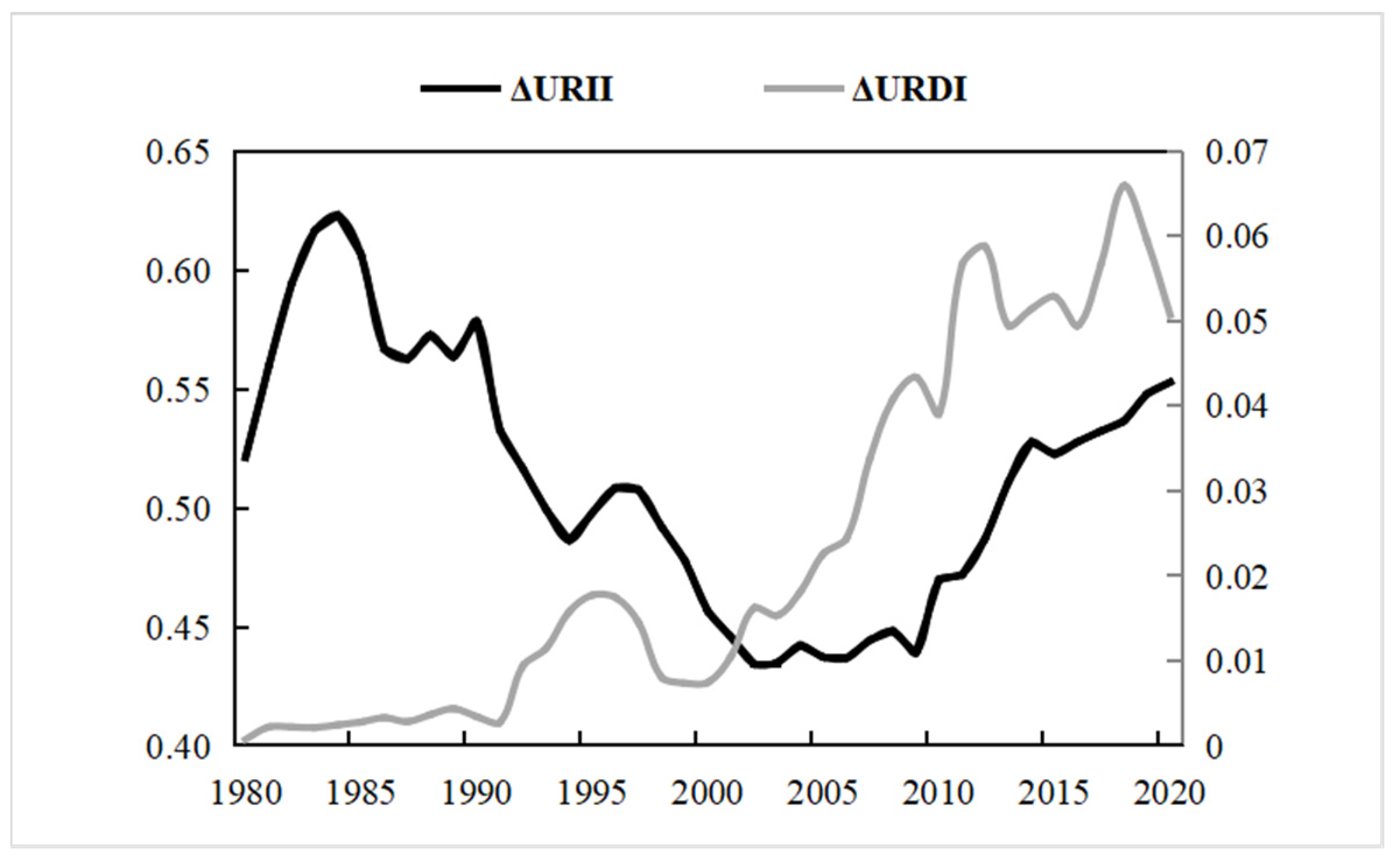
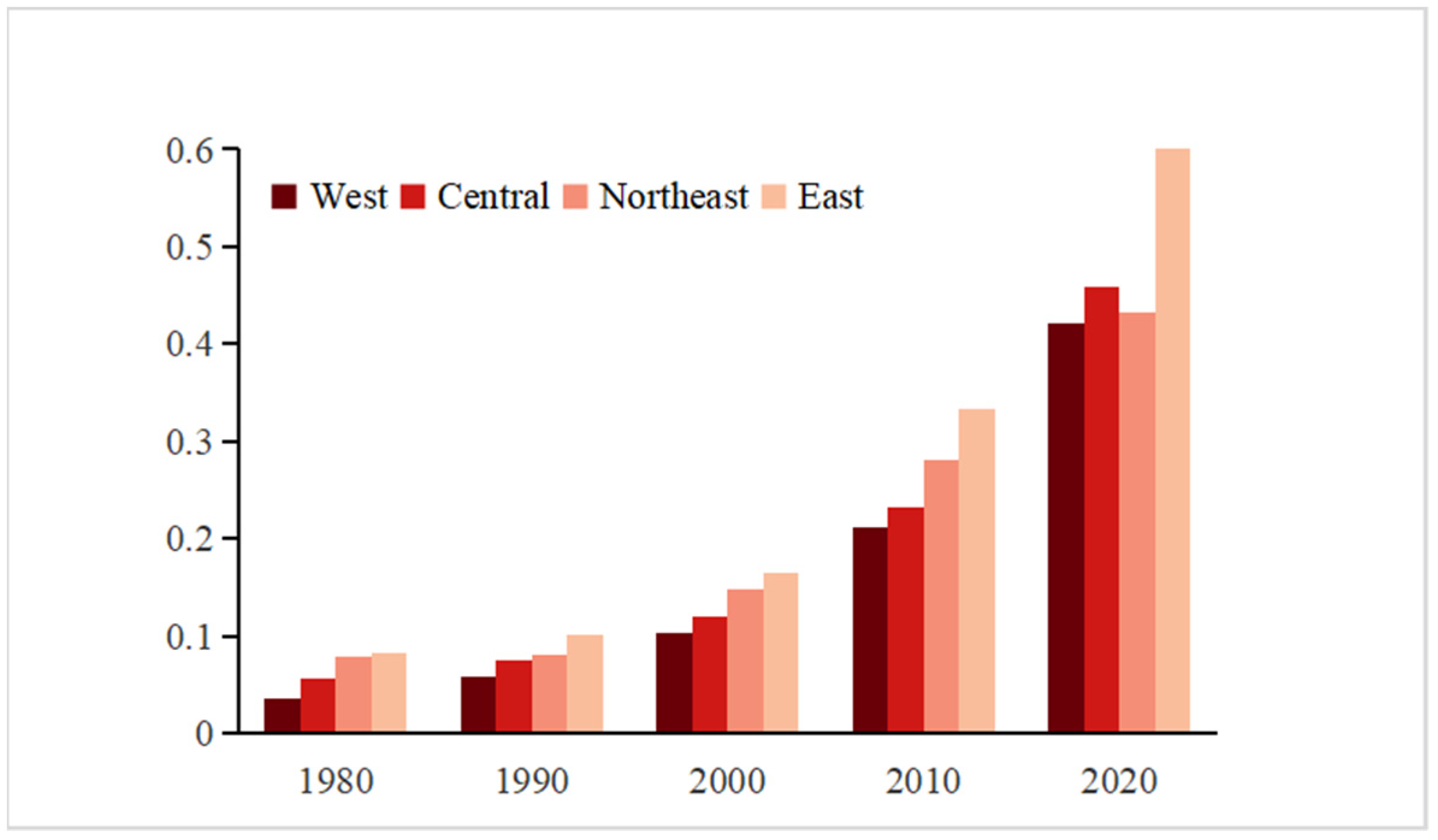

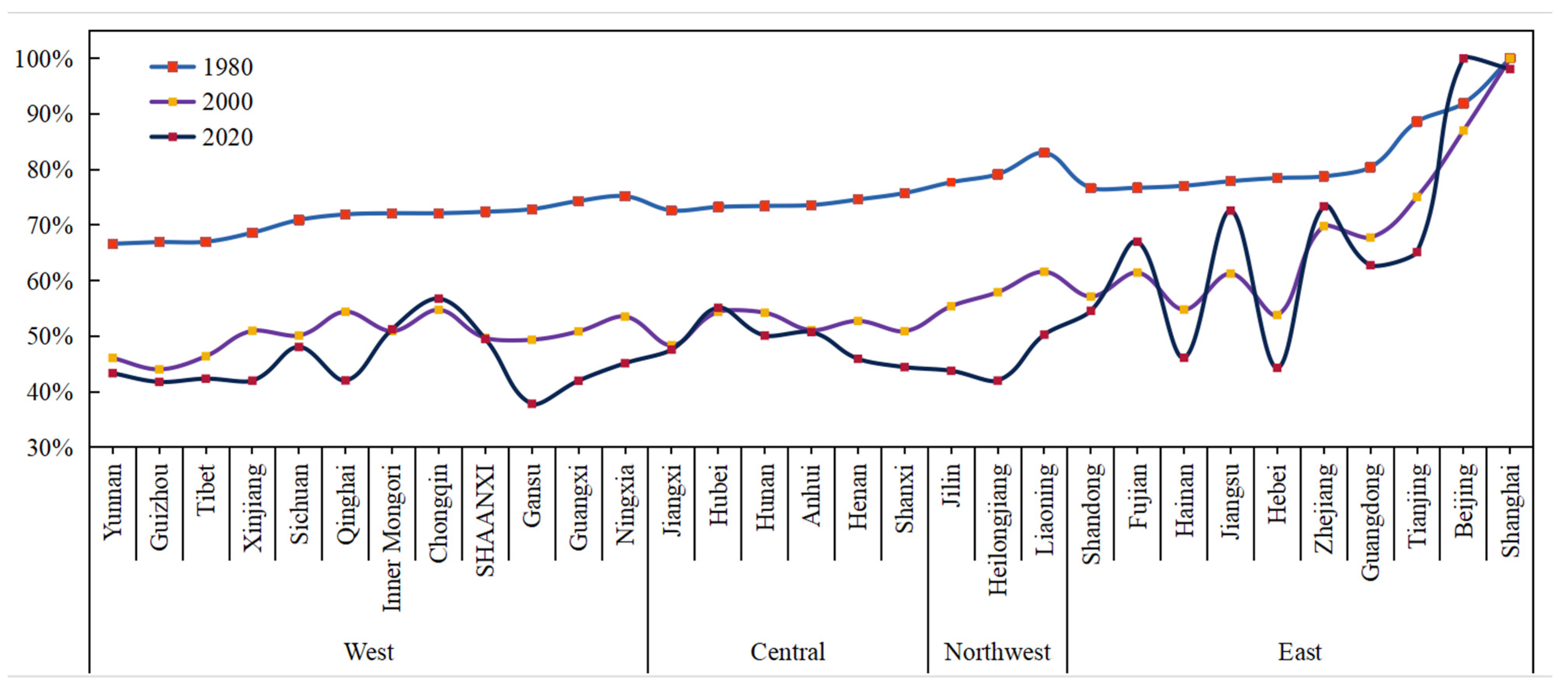






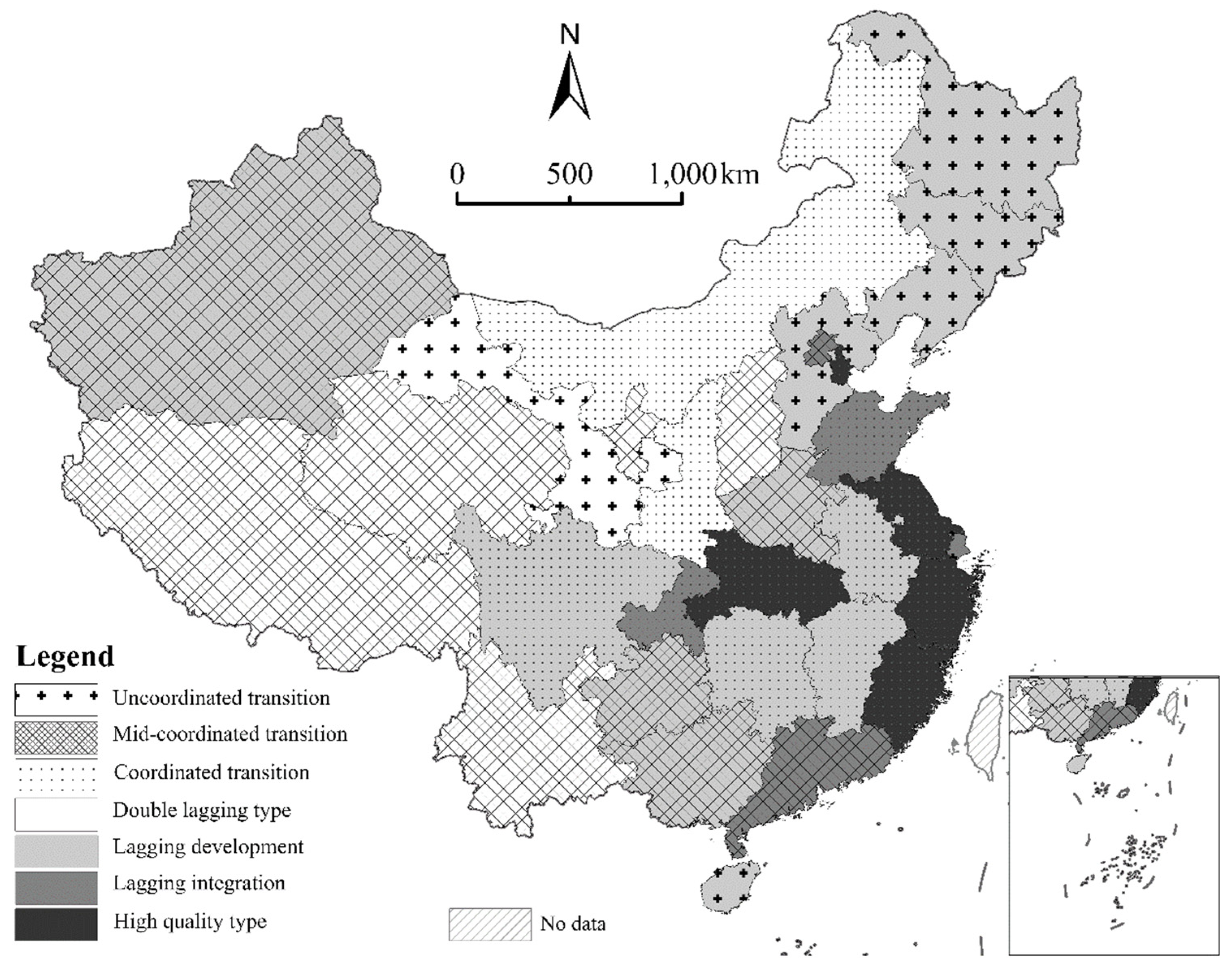
| Index | Indicator Layer | Definition | Weight |
|---|---|---|---|
| URDI | Income | Per capita disposable income | 0.364 |
| Production | Per capita GDP | 0.256 | |
| Consumption | Per capita household expenditure | 0.175 | |
| Livelihood | Per capita food expenditure/per capita household expenditure | 0.205 | |
| URII | Rural–urban income disparity | Rural per capita disposable income/Urban per capita disposable income | 0.346 |
| Rural–urban production disparity | Rural per capita GDP/urban per capita GDP | 0.292 | |
| Rural–urban consumption disparity | Rural per capita household expenditure/urban per household expenditure | 0.219 | |
| Rural–urban livelihood disparity | Urban Engel’s coefficient/rural Engel’s coefficient | 0.142 |
Disclaimer/Publisher’s Note: The statements, opinions and data contained in all publications are solely those of the individual author(s) and contributor(s) and not of MDPI and/or the editor(s). MDPI and/or the editor(s) disclaim responsibility for any injury to people or property resulting from any ideas, methods, instructions or products referred to in the content. |
© 2023 by the authors. Licensee MDPI, Basel, Switzerland. This article is an open access article distributed under the terms and conditions of the Creative Commons Attribution (CC BY) license (https://creativecommons.org/licenses/by/4.0/).
Share and Cite
Zhang, S.; Zhao, J.; Jiang, Y.; Cheshmehzangi, A.; Zhou, W. Assessing the Rural–Urban Transition of China during 1980–2020 from a Coordination Perspective. Land 2023, 12, 1175. https://doi.org/10.3390/land12061175
Zhang S, Zhao J, Jiang Y, Cheshmehzangi A, Zhou W. Assessing the Rural–Urban Transition of China during 1980–2020 from a Coordination Perspective. Land. 2023; 12(6):1175. https://doi.org/10.3390/land12061175
Chicago/Turabian StyleZhang, Shiwei, Jinghui Zhao, Yanfeng Jiang, Ali Cheshmehzangi, and Wenbin Zhou. 2023. "Assessing the Rural–Urban Transition of China during 1980–2020 from a Coordination Perspective" Land 12, no. 6: 1175. https://doi.org/10.3390/land12061175
APA StyleZhang, S., Zhao, J., Jiang, Y., Cheshmehzangi, A., & Zhou, W. (2023). Assessing the Rural–Urban Transition of China during 1980–2020 from a Coordination Perspective. Land, 12(6), 1175. https://doi.org/10.3390/land12061175











